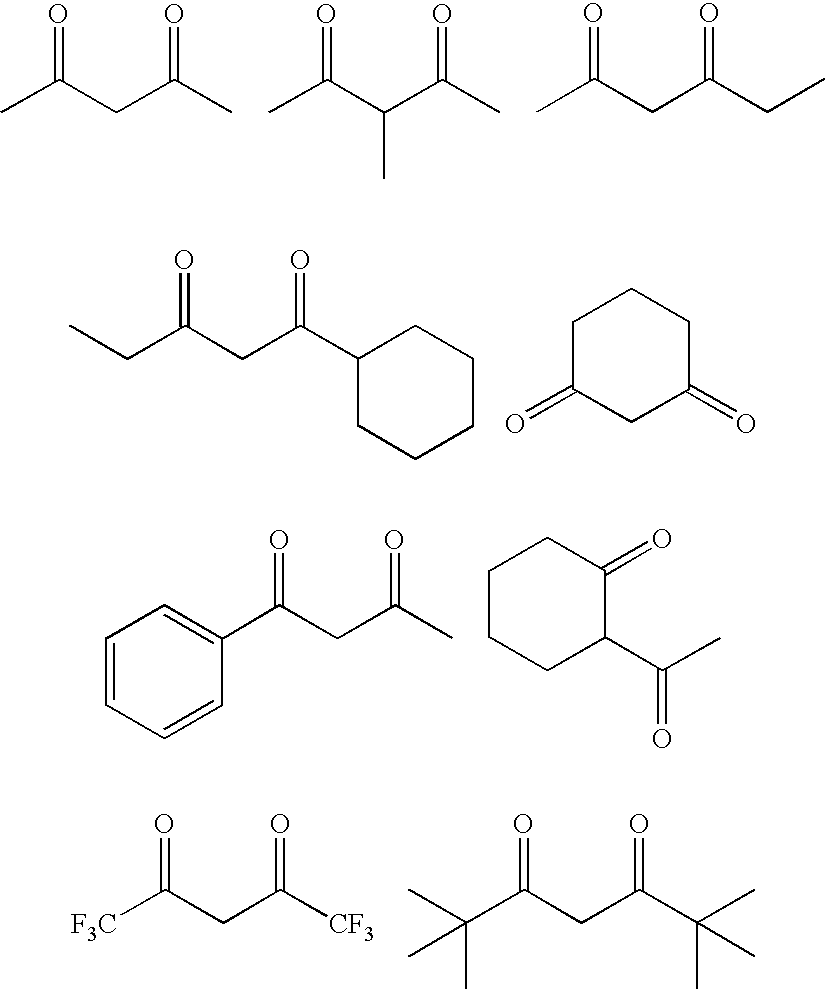Removal of metal contaminants from polyethylene
a metal contamination and polyethylene technology, applied in the direction of dyeing process, natural resin process, chemical apparatus and processes, etc., can solve the problems of residual metal contaminants, relatively high temperature of solution process, and certain end-use applications, and achieve low metal levels, good properties, and minimal degradation and condensation products
- Summary
- Abstract
- Description
- Claims
- Application Information
AI Technical Summary
Benefits of technology
Problems solved by technology
Method used
Image
Examples
example 1
[0023]Model reactions are performed by heating a combination of acetylacetone, basic alumina, and an alcohol in a hexane solution. This simulates a portion of the chemistry that may occur when acetylacetone and an alcohol are added to a solution of polyethylene containing metal contaminants that is then passed through basic alumina.
[0024]Basic alumina (grade Polycel 860 available from Porocel Corp.) is dried at 300° C. for 24 hours under a nitrogen flow in a muffle furnace. The alumina is cooled to room temperature in a nitrogen-purged box. After cooling, it is taken into a nitrogen-purged glove bag and stored in a sealed bottle under nitrogen until ready for use. A clean, dry, 1-L Parr reactor (unstirred) is taken into the glove bag, and 66 mL of the alumina is placed into the Parr reactor. A solution consisting of acetylacetone (1.39 g, 13.9 mmol, from Wacker Chemie AG), 1-propanol (0.42 g, 7.0 mmol, from Fisher Scientific, Inc.), and hexane (125 g) is added to the Parr reactor. T...
example 5
[0035]The procedure of Example 1 is repeated, with the exception of using 1-butanol rather than 1-propanol and using a molar ratio of β-diketone to alcohol of 2:1.
TABLE 1Alumina AnalysesMolarIsophorone2-PropanolAcetoneExampleAlcoholratioYIb valueareaareaarea11-propanol2:124.713.118126303C2noneNA40.621.997 0214C32-propanol3:138.319.7140NA323C4t-butanol3:136.618.5162 028151-butanol2:128.015.015168315
[0036]Example 5 demonstrates that a large decrease in isophorone level and remarkable color improvement are observed with the primary alcohol, 1-butanol. In contrast, Comparative Examples 3 and 4 show that the color improvement and large decrease in isophorone observed in Examples 1 and 5 are not achieved. This indicates that secondary and tertiary alcohols are not as effective as primary alcohols.
example 6
[0037]The procedure of Example 1 is repeated, with a molar ratio of β-diketone to 1-propanol of 3:1.
PUM
| Property | Measurement | Unit |
|---|---|---|
| temperature | aaaaa | aaaaa |
| boiling point | aaaaa | aaaaa |
| boiling point | aaaaa | aaaaa |
Abstract
Description
Claims
Application Information
 Login to View More
Login to View More - R&D
- Intellectual Property
- Life Sciences
- Materials
- Tech Scout
- Unparalleled Data Quality
- Higher Quality Content
- 60% Fewer Hallucinations
Browse by: Latest US Patents, China's latest patents, Technical Efficacy Thesaurus, Application Domain, Technology Topic, Popular Technical Reports.
© 2025 PatSnap. All rights reserved.Legal|Privacy policy|Modern Slavery Act Transparency Statement|Sitemap|About US| Contact US: help@patsnap.com

